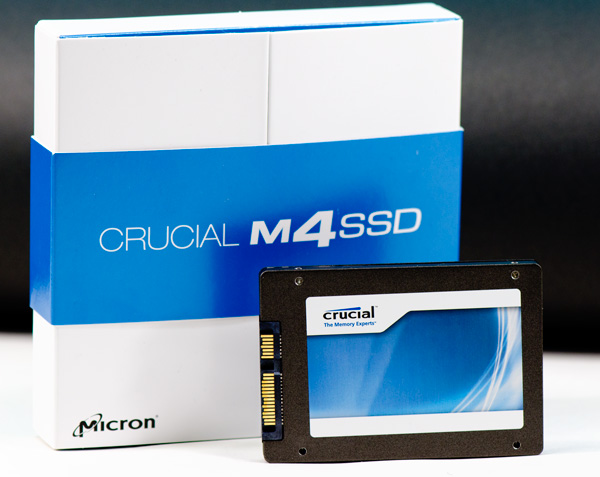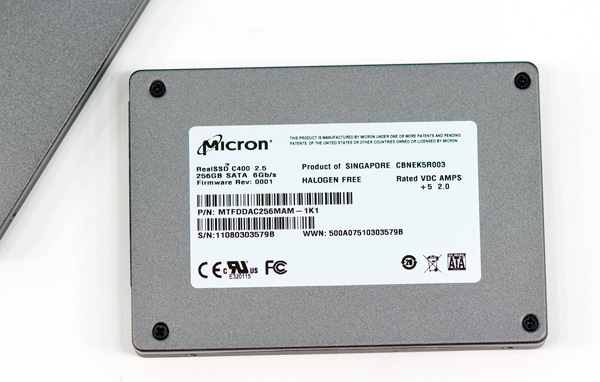The Crucial m4 (Micron C400) SSD Review
by Anand Lal Shimpi on March 31, 2011 3:16 AM ESTFinal Words
I'm not sure whether to call the m4 an evolutionary upgrade in performance or a shift in performance. Write speed is faster across the board, but read speed took a definite hit compared to the C300. Overall Crucial has a faster drive on its hands, one that's particularly well suited to most of our lighter workloads. It's only in our new 2011 heavy multitasking workload that the m4 really fell short. For your average desktop usage model, the m4 is either the best or second best you can get.
I am a bit put off by the fact that the m4 doesn't seem to have the peak sequential performance of some of the other next-generation drives we've reviewed. The Vertex 3 and Intel SSD 510 both do much better in sequential transfer speeds than the m4. To Crucial's credit however, without any data deduplication/compression it delivers the best 4KB random write performance we've seen to date.
My remaining concerns with the m4 are really not that different from those I had with the C300. Crucial's very late garbage collection allows the possibility for some very poor write speeds over time. If you're running in a configuration without TRIM support, I'd say this is enough to rule out the m4. Sure performance should recover with sequential write passes, however if your workload isn't sufficiently sequential then this could pose a problem. If you do have a TRIM enabled OS I'm not entirely sure how the m4 will behave over time. TRIM should keep things running smoothly but that will largely depend on workload. Again, I think that for most desktop/notebook users the m4 will do just fine but it's tough to say for sure without months of testing under my belt. In other words, like any other brand new SSD—approach with caution.
We should have the final Vertex 3 in house soon, but it's looking like all cards are on the table for this round. If SandForce/OCZ can manage to deliver a well tested, reliable product it may be difficult to recommend an alternative.












103 Comments
View All Comments
Drag0nFire - Thursday, March 31, 2011 - link
Dear Anand,Thank you so much for your comments on NAND longevity. Very much appreciated to go through the math one more time in the context of these drives.
One remaining question: is your assumption of 7GB per day really appropriate. If I have a laptop with 4GB of RAM (not rare today) and I hibernate my laptop (or use hybrid sleep) an average of twice a day, I've already exceeded your usage scenario.
I understand that I should still not be concerned about the longevity of the drives... but perhaps a more conservative estimate for the math would be appropriate.
Thanks,
--Jonathan
sor - Thursday, March 31, 2011 - link
If you are hibernating your laptop twice a day, you're doing it wrong. That's what suspend to RAM is for, your laptop should last up to a few days in that state. Only hibernate when battery is low (or just shut down).I was thinking 7GB/day average is actually fairly high, considering that playing games, web browsing, and document editing are all fairly light on writes.
Chloiber - Friday, April 1, 2011 - link
How much RAM are you using? You laptop only writes RAM on your disk which is actually used.However, I also think 7GB/day isn't that much. On my desktop I'm at over 10GB/d (Postville, using since July '09).
Still, I don't think that NAND lifetime is an issue. You should worry more about firmware bugs. That's the thing that kills your data more than anything else at the moment.
wrickard - Thursday, March 31, 2011 - link
I think the test results should include the firmware revisions.Seems these can affect performance significantly.
Could you add a note with the firmware revisions in the reviews?
Bozzunter - Thursday, March 31, 2011 - link
Anand: TRIM appears to be finally available, for any drive, on Mac Os, do you plan to run some tests there, too? Check http://www.groths.org/?p=308.MilwaukeeMike - Thursday, March 31, 2011 - link
Have you ever considered creating a benchmark based on type of user? Make up some names and show them which drive would be the best for them. Frank the multitasker has to open 75 word docs a day, view power points, excel sheets, move documents around and convert docs to .PDF. Here's how the drives perform for this type of user. Sue the gamer hates waiting for screens to load while travelling between zones in her favorite MMO, here's how the drives perform for her. Bob the buildier is a software developer and blogger. He has to move large video files around, and uses larger programs like visual studio and photoshop... etc... you get the idea. Call me ingorant, but i have no idea how 4KB write speed with no queue depth translates into real-world use, let alone noticeable real-world use.I'm not ripping the review, i think it's very comprehensive, we just need some better translating for us lay people.
thesegreydays - Thursday, March 31, 2011 - link
Anand, thanks for another great review!However, I'm anticipating Corsairs new offerings and I haven't really heard any news about the Force GT since CeBIT.
Are you going to release a review of it in the near future and is Corsair still aiming for a "early 2nd quarter" release?
Modus - Thursday, March 31, 2011 - link
Some SSD's reduce the number of NAND channels for their smaller capacity models of the same line, reducing performance on certain workloads. I'm always disappointed when reviewers don't go back and test the smaller capacity versions. Since most users still benefit most from a small SSD as an OS/apps/game drive to complement a larger mass-storage HD, these same users will often end up with smaller 40~60~80 GB SSD's, and it's often hard to find performance reviews of these drives from top-tier sites like AnandTech.Anand, we love the job you do. I just want to remind you to not forget about the smaller drive capacities. And I do see that your Bench database contains some of those. But like most reviewers, you seem to be naturally focused on the high-end capacities.
KineticHummus - Thursday, March 31, 2011 - link
Anandtech normally focuses on the high-end because that is what is sent to them to review. They do not normally go out and purchase these drives, the manufacturers send them in, so it is the manufacturer's choice which drives are reviewed and which arent.vedye - Thursday, March 31, 2011 - link
Just started reading about SSDs and noticed how the TRIM command can affect the performance.A quick question, is format the only way to trigger TRIM? i.e. to use C4 for Windows 7 (that supports Trim) as OS disk, does it mean i need to format and reinstall the OS every now and then?
Cheers